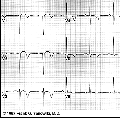11. T Wave Abnormalities
Introduction
The T wave is the most labile wave in the ECG. T wave changes including low-amplitude T waves and abnormally inverted T waves may be the result of many cardiac and non-cardiac conditions. The normal T wave is usually in the same direction as the QRS except in the right precordial leads (see V2 below). Also, the normal T wave is asymmetric with the first half moving more slowly than the second half. In the normal ECG (see below) the T wave is always upright in leads I, II, V3-6, and always inverted in lead aVR. The other leads are variable depending on the direction of the QRS and the age of the patient.
Differential Diagnosis of T Wave Inversion
- Q wave and non-Q wave MI (e.g., evolving anteroseptal MI):
- Myocardial ischemia
- Subacute or old pericarditis
- Myocarditis
- Myocardial contusion (from trauma)
- CNS disease causing long QT interval (especially subarrachnoid hemorrhage; see below):
- Idiopathic apical hypertrophy (a rare form of hypertrophic cardiomyopathy)
- Mitral valve prolapse
- Digoxin effect
- RVH and LVH with "strain" (see below: T wave inversion in leads aVL, V4-6 in LVH)





